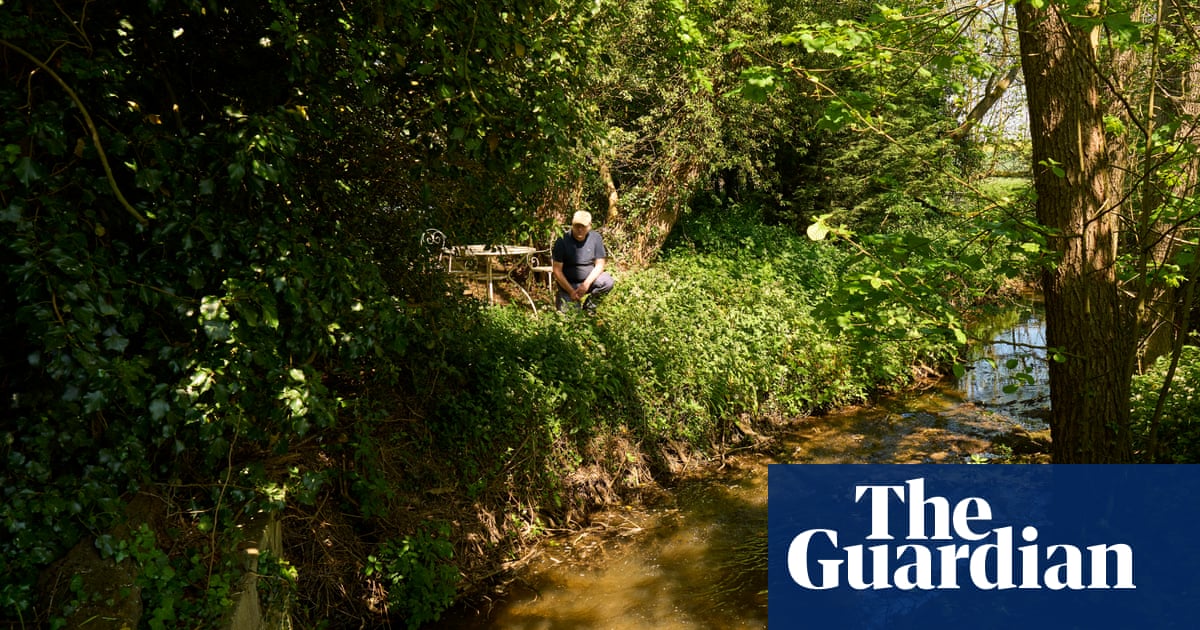Pesticides, antibiotics, animal medicines: the chemical cocktail seeping into our rivers | Rivers

Rivers carry more than just water through Britain’s landscapes. A hidden cocktail of chemicals seeps out of farmland, passes undetected through sewage treatment works, and drains off the roads into the country’s rivers. Normally these chemicals flow through unreported, silently restructuring ecosystems as they go, but now, UK scientists are building a map of what lies within – and the damage it may be causing.
Trailing down the centre of Britain is one river whose chemical makeup scientists know better than any other. The Foss threads its way through North Yorkshire’s forestry plantations, patchworked arable land and small hamlets, before descending into the city of York, passing roads and car parks, gardens replacing farmland. Along the course of its 20-mile (32km) length, the chemical fingerprints of modern life accumulate.
“The Foss is the river that we understand the most,” says Prof Alistair Boxall from the University of York, who has been leading the research across Yorkshire’s rivers. He leads the Ecomix research project which studies 10 rivers across the region, developing ways to examine these chemicals in greater depth than ever before. “This is the chemical pulse of Yorkshire water,” he says, and the findings from the water here are likely to be replicated across the country. “People are surprised. They typically think of plastics and sewage. People don’t make the connection between the chemicals we use and the environment.”
The story these rivers are telling is worrying, says Boxall. Among the thousands of chemicals detected was the tyre additive 6PPD-quinone, which has been linked with mass salmon die-offs in the US. In urban sites across Sheffield, Leeds and Wakefield it was found in about three-quarters of samples. Fungicides and herbicides were among the most detected chemicals.
About 500 pesticides – which includes insecticides, fungicides and herbicides – are approved for use in Europe, and 600 are greenlit for veterinary use on livestock and pets. Research has shown antihistamine levels in the water rise when hay fever is bad – one of many pharmaceuticals that end up in rivers after being flushed down the toilet.
Monitoring the Foss started in Stillington Mill, in the back garden of a former headteacher. He is one of the volunteers who made this research possible – either by taking samples or allowing monitoring to be done on their land.
This spot is about 10 miles from the source of the Foss. Fields of wheat and oilseed rape back on to the water from the other side of the river. Three thousand chemicals were detected here (of which 40% are likely to occur naturally). In the targeted analysis scientists identified 40 chemicals including livestock medicines, pharmaceuticals, UV filters, fungicides and herbicides.
In total they were looking for 52 chemicals (excluding metals) and found 44 across the three sampling sites on the Foss. They chose to focus on these chemicals because they are known for toxicity and potential harm to aquatic organisms.
By the time it reaches York city centre – about another 10 miles away – an additional 1,000 chemicals have been added to the river, including household chemicals such as antibiotics and cosmetics as the river passes from agricultural areas into villages and towns. On the outskirts of York at New Earswick, Boxall documented the second highest level of paracetamol in the water ever measured in Europe, after a sewage system failure. It was 1,000 times the normal level.
In the lab
In Boxall’s lab, a set of creatures he calls “little beasties” live in fish tanks – a tiny menagerie including duck mussels, swan mussels, ramshorn snails, bloodworms and leeches collected in the ponds around campus. These are species commonly found in UK rivers. Twelve cultures of cyanobacteria – blue-green algae – are siphoned around, each a slightly different shade of green. “Algae are the base of the food chain,” he says. Here, the invertebrates and algae are exposed to different chemicals and scientists are monitoring the effects.
This is the other focus of the Ecomix research: working to understand the effects chemicals are having on the ecology of British rivers. One in 10 freshwater and wetland species in England is threatened with extinction. Boxall believes chemical pollution could be as bad for river ecosystems as sewage spills, which regularly make headlines.
Researchers have found that chemical pollution makes a “significant” contribution to the decline of fish and other aquatic organisms, one that is often missed by regulators.
More than 350,000 chemicals are registered for production and use, with about 2,000 new ones added each year. They are probably having a range of unknown negative effects on the ecology of our rivers – changing organisms’ behaviour and physiology. Chemicals have been shown to have a diverse impact on fish, including their reproduction, social interactions and feeding behaviour. Studies suggest ibuprofen can affect fish hatching, the anti-inflammatory diclofenac affects fish livers, and antidepressants have been linked to a range of behavioural changes. Salmon exposed to anti-anxiety medication have been shown to take more risks, and some flea treatments like imidacloprid are toxic to invertebrates such as mayflies and dragonflies.
“You’ve effectively got a situation where some chemicals are hitting the base of the food web, others are hitting the invertebrates, and you’ve got other chemicals hitting the fish,” says Boxall.
The Ecomix study is far more comprehensive than chemical modelling by the Environment Agency, which focuses mainly on “grab samples”, or monthly monitoring at best. Boxall’s study looked at 19 sites across 10 rivers over a year of continuous monitoring, during which 20,000 samples were collected.
“The Environment Agency doesn’t have the resources to tackle this issue well enough,” said Rob Collins from the Rivers Trust, who was not involved in the research. He added that controlling these chemicals at source was key: “It is a societal challenge to tackle this problem – we are all involved. We also need to see much stronger government regulation with more hazardous chemicals.
“Once these chemicals get into the environment it’s very hard to do anything about them. For example, Pfas – known as ‘forever chemicals’ – can persist in the environment for more than 1,000 years.”
Citizen scientists
Richard Hunt was one of a dozen citizen scientists who has made this research possible. The results were “sobering”, said Hunt, who took a weekly sample in the centre of York. His was among the sites with the highest level of chemicals – as expected in an urban area. UV filters, fire retardants, de-wormers, DEET and cocaine were among the things swirling around in the water. “I was gobsmacked by the number of chemicals,” says Hunt. “If people were instructed on how they could help, they would.”
The holy grail for addressing chemical pollution is a constant monitoring system, reporting in real time, says Boxall. Having live updates would alert authorities to possible pollution issues so they could respond faster, although Environment Agency staff have been told to ignore low-impact pollution events because the body does not have the resources to investigate.
“Chemicals are important for society,” says Boxall. “We benefit from them, but we need to reduce their environmental harm.”
Hunt points out that the wealth of his city came from its two rivers – the Ouse and its tributary, the Foss. Understanding what chemicals are flowing through them and working out what we can do to clean it up would be to repay adebt of gratitude. “York wouldn’t be nearly as healthy and successful if not for the rivers. We need to have more respect for them.”
Find more age of extinction coverage here, and follow the biodiversity reporters Phoebe Weston and Patrick Greenfield in the Guardian app for more nature coverage
Source link






